

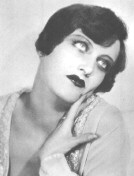
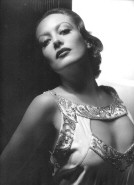




The Best of P
Anita Page • Paid • Jack Palance • Pally Award • Betsy Palmer • Paris • Suzy Parker • Parnell • Louella Parsons • Passing Show of 1924 • Password • Pepsi-Cola • Pets • Phone Numbers • Mary Pickford • Zasu Pitts • Plaza Art Galleries • Poetry • Poivre • A Portrait of Joan • Possessed '31 • Possessed '47 • William Powell • Otto Preminger • Elvis Presley • Pretty Ladies • Proud Flesh • Pucci Pants
 Page,
Anita. (8/4/1910 - 9/6/2008) Born
"Anita Pomares" in Queens, NY, this early MGM star co-starred
with Joan in four films:
Our Dancing Daughters
(1928), Our Modern Maidens
(1929), Hollywood Revue
of 1929, and Our Blushing Brides
(1930). She also made a Baby Jane-ish appearance in the 2002 Joan TCM doc "The
Ultimate Star." See also this 2000
interview with Page,
which reveals:
Page,
Anita. (8/4/1910 - 9/6/2008) Born
"Anita Pomares" in Queens, NY, this early MGM star co-starred
with Joan in four films:
Our Dancing Daughters
(1928), Our Modern Maidens
(1929), Hollywood Revue
of 1929, and Our Blushing Brides
(1930). She also made a Baby Jane-ish appearance in the 2002 Joan TCM doc "The
Ultimate Star." See also this 2000
interview with Page,
which reveals:
Her rivalry with the sexually voracious Joan Crawford caused increasing tension at MGM. "I ended up loathing Joan," says Page. "For one thing she tried to hit on me several times. Let me tell you, when my mother saw the sex aids in various shapes and colours that Joan kept in her medicine cabinet, she refused my ever seeing Joan again - apart from on a film set."
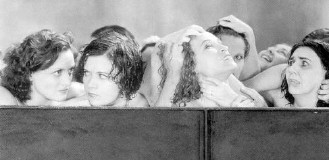 Paid.
MGM, 1930. Directed by Sam Wood, 80 minutes. Joan stars
as ex-con "Mary Turner," wrongly accused and now out to get revenge,
with the help of her gangster friends, on the powerful men who
set her up. Based on the 1912 play "Within the Law" by Bayard Veiller,
two silent film versions were made with that name: in 1917 (starring Alice Joyce)
and 1923 (starring Norma Talmadge). This time around, MGM star (and wife of
MGM production head Thalberg) Norma Shearer wanted the part, but became pregnant,
so Joan took over.
Paid.
MGM, 1930. Directed by Sam Wood, 80 minutes. Joan stars
as ex-con "Mary Turner," wrongly accused and now out to get revenge,
with the help of her gangster friends, on the powerful men who
set her up. Based on the 1912 play "Within the Law" by Bayard Veiller,
two silent film versions were made with that name: in 1917 (starring Alice Joyce)
and 1923 (starring Norma Talmadge). This time around, MGM star (and wife of
MGM production head Thalberg) Norma Shearer wanted the part, but became pregnant,
so Joan took over.
Says Joan in CWJC: ...my first really heavy dramatic role, and I did a good job, a damned good job, thanks to Sam Wood and a script by Charlie MacArthur.
Says Joan in Portrait of Joan:
When I first married
Douglas [1929], I was fighting for emotional, dramatic parts because
I am dramatic and emotional. I wanted self-expression.
My first chance came in a picture that for years was my favorite---Paid. The remake from the famous old play Within the Law had been planned for Norma Shearer, but Norma became pregnant and I begged to take her place....
How did I get hold of that script? I was always a script stealer. Totally engrossed, I read this story of the department-store clerk railroaded to prison, who emerges with one thought, revenge. I pleaded with Hunt Stromberg, the producer, pleaded with Mr. Mayer, and against their better judgment, the part was mine. This moment was crucial career-wise. I knew if I scored a triumph I'd surprise my fans and attract a new audience. I knew too that if I failed I'd lose the audience I had built up and gain nothing. My dancing-daughter days were over, so far as I was concerned.
The distinguished Charles Bickford, whom I'd never met, was visiting on the set. He came up and kissed my hand after the courtroom scene. I wonder if he knows what confidence he gave me, that dynamic actor with his shock of red hair! "You're going to be a great star," he said. I'd begun to feel the prickles of stardom already. "But am I going to be a good actress?" I cried.
Some critics said yes. Variety said, "Histrionically she impresses us as about ready to stand up under any sort of dramatic assignment."
I treasured that. I pasted it into the scrapbook stuffed with clippings, and right next to it, the telegram from Marlene Dietrich, whom I had never met. She liked Paid too....
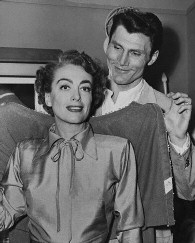 Palance,
Jack. (2/18/1919 -11/10/2006) Born "Vladimir Palaniuk" in
Pennsylvania, Palance, whose father was a coal-miner, had a
boxing career in the '30s and '40s before serving in WWII, where
a fiery B-24 crash forced extensive facial surgery, contributing
to his odd looks.
Palance,
Jack. (2/18/1919 -11/10/2006) Born "Vladimir Palaniuk" in
Pennsylvania, Palance, whose father was a coal-miner, had a
boxing career in the '30s and '40s before serving in WWII, where
a fiery B-24 crash forced extensive facial surgery, contributing
to his odd looks.
After the war, Palance turned to acting; he made his film debut in 1950's Panic in the Streets and co-starred with Joan in 1952's Sudden Fear. (Only his third film, he received an Oscar nomination for his performance; he received a second nom the next year for Shane.)
He and Joan didn't get along too well on the set, for various reasons: One, Joan initially wanted the ageing Gable for the role of the young playwright Lester Blaine and actually burst into tears when director David Miller suggested the offbeat-looking and at the time unknown Palance (JCB); secondly, not only was he moody and method-actorish on the set, he was also busy pursuing co-star Gloria Grahame and didn't respond to Joan's advances. After filming, he was quoted as saying about Joan: "Look, I don't want any more squabbles with Crawford. I have my future to think about. She's difficult. Unless she's handled properly she's lots of trouble. She's a woman and has to have her way in everything." (DF)
He went on to a lengthy film and TV career playing mostly villains in noirs and Westerns (receiving an Emmy for 1957's TV performance in Playhouse 90's "Requiem for a Heavyweight") and was most recently known for his performance as "Curly" in the City Slickers movies of the '90s (receiving his only Oscar, for Best Supporting Actor, for the first Slickers).
Pally Award. According to Wikipedia, Joan was the recipient of the 6th Annual Pally, given out by Pepsico to employees making "significant contributions to company sales." The award came in the shape of a bronze Pepsi bottle, and Joan allegedly kept it in a place of honor next to her Oscar for Mildred Pierce. (I'm assuming husband Al Steele, president of Pepsi, initiated this award, given his propensity for calling people "Pally"...No info on the exact year she was so honored.)
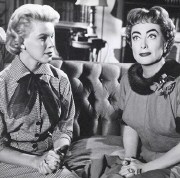 Palmer,
Betsy. (11/1/26 - 5/29/15) Born
"Patricia Betsy Hrunek" in Indiana, Palmer began her acting
career on TV in 1951 and is perhaps best known for her nearly 50
years of TV appearances, including a 10-year stint (1957 to
1967) as a panelist on "I've Got a Secret" (an episode
in '61 featured her and Joan re-enacting a scene from their 1955
movie, Queen
Bee),
as well as on later shows like "Knots Landing" and "Murder,
She Wrote." Movie-wise, aside from Queen Bee, her
most famous roles were probably in 1955's Mister Roberts
and 1980's Friday the 13th.
Palmer,
Betsy. (11/1/26 - 5/29/15) Born
"Patricia Betsy Hrunek" in Indiana, Palmer began her acting
career on TV in 1951 and is perhaps best known for her nearly 50
years of TV appearances, including a 10-year stint (1957 to
1967) as a panelist on "I've Got a Secret" (an episode
in '61 featured her and Joan re-enacting a scene from their 1955
movie, Queen
Bee),
as well as on later shows like "Knots Landing" and "Murder,
She Wrote." Movie-wise, aside from Queen Bee, her
most famous roles were probably in 1955's Mister Roberts
and 1980's Friday the 13th.
In 1960, she and Joan were two of the seven recipients of the Millinery Institute of America's "Golden Hat Awards." And in 2002, Palmer appeared in the TCM Joan doc "The Ultimate Star," in which she talked about Joan and John Ireland's hijinx on the set of Queen Bee.
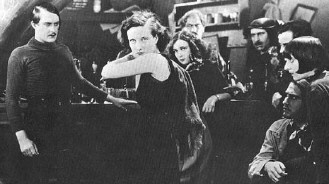 Paris.
MGM silent, 1926. Directed by Edmund Goulding, 67 minutes. Joan plays "The
Girl," a denizen of the louche Parisian "apache" life whom a
young rich American (Charles Ray) falls in love with. Douglas
Gilmore plays her mean boyfriend, "The Cat."
Says Joan in CWJC: I did a lousy job...overacting like a simpleton.
Paris.
MGM silent, 1926. Directed by Edmund Goulding, 67 minutes. Joan plays "The
Girl," a denizen of the louche Parisian "apache" life whom a
young rich American (Charles Ray) falls in love with. Douglas
Gilmore plays her mean boyfriend, "The Cat."
Says Joan in CWJC: I did a lousy job...overacting like a simpleton.
 Parker,
Suzy. (10/28/32 - 5/3/03) This
San Antonio-born/New Jersey-raised supermodel was signed at age
15 by the Ford Agency (after the recommendation of her sister, model
Dorian Leigh) and went on to become the face of Chanel and one of
the highest paid, most photographed models in the world. She
made her acting debut in 1957's Funny Face and also appeared
in '57's Kiss Them For Me, as well as co-starring with Joan
in 1959's The
Best of Everything.
She married actor Bradford Dillman in 1963, a union that lasted
until her death in 2003. Her last acting job was in a 1970 episode
of "Night Gallery."
Parker,
Suzy. (10/28/32 - 5/3/03) This
San Antonio-born/New Jersey-raised supermodel was signed at age
15 by the Ford Agency (after the recommendation of her sister, model
Dorian Leigh) and went on to become the face of Chanel and one of
the highest paid, most photographed models in the world. She
made her acting debut in 1957's Funny Face and also appeared
in '57's Kiss Them For Me, as well as co-starring with Joan
in 1959's The
Best of Everything.
She married actor Bradford Dillman in 1963, a union that lasted
until her death in 2003. Her last acting job was in a 1970 episode
of "Night Gallery."
Parnell. This 1937 MGM dud starring Clark Gable (considered his biggest flop ever, losing over $637,000) as a 19th-century Irish politician was initially slated to co-star Joan. After a disagreement with director John Stahl (and disliking the script to begin with), Joan switched assignments with Myrna Loy and appeared in The Last of Mrs. Cheyney (co-starring William Powell) instead. According to JCB, Gable was furious with Joan over her departure; as a result, she also refused to appear in Saratoga with him (Jean Harlow took over her part in that movie). Joan and Clark didn't speak for nearly 3 years, until they reunited in 1940's Strange Cargo (their last film together).
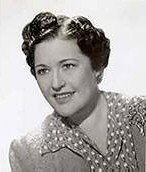 Parsons,
Louella. (8/6/1881 - 12/9/1972) The
world's first movie gossip columnist was born in Illinois, moved
to Iowa with her first husband, then after their divorce went to
Chicago, where she wrote for Chaplin's Essanay Studios before beginning
her first gossip column in 1914, for the Chicago Record-Herald.
When media mogul William Randolph Hearst bought the paper in 1918,
he fired Parsons, who then moved to NYC, where she had a column
for the New York Movie Telegraph. In 1922, Hearst, realizing
the error of his ways, hired her for his New York America
paper.
Parsons,
Louella. (8/6/1881 - 12/9/1972) The
world's first movie gossip columnist was born in Illinois, moved
to Iowa with her first husband, then after their divorce went to
Chicago, where she wrote for Chaplin's Essanay Studios before beginning
her first gossip column in 1914, for the Chicago Record-Herald.
When media mogul William Randolph Hearst bought the paper in 1918,
he fired Parsons, who then moved to NYC, where she had a column
for the New York Movie Telegraph. In 1922, Hearst, realizing
the error of his ways, hired her for his New York America
paper.
After contracting TB, Parsons moved to Los Angeles for health reasons in 1925, where she began her famed column for Hearst's Los Angeles Examiner, which would eventually be syndicated to over 600 papers worldwide, with a readership of over 20 million. (She also had a radio show, beginning in 1928.) Parsons remained unchallenged in gossip supremacy until 1937, when Hedda Hopper began her own column in a rival non-Hearst paper, sparking a feud between the two that would last for decades. Parsons' column ran until December 1965.
Parsons had a role in at least a couple of major Joan-stories. In July 1932, Joan initially gave the scoop to her friend, Modern Screen writer Katharine Albert, that she was divorcing Doug Jr. Since that magazine was monthly, though, Albert had to sit on the story; in the meantime, Parsons found out about the news and rushed to Joan's house, forcing her to fess up then using Joan's own typewriter to type up the column proclaiming their divorce, which appeared the next day in Hearst papers everywhere. (DF)
Later, in 1959 on the set of The Best of Everything, Parsons would get another Joan scoop, which appeared in the LA Examiner under the head "Joan Crawford Flat Broke." (JCB) Here, Joan revealed to Parsons that husband Al Steele, when he died, had left her "up to my ears in debt, Louella. He expected his company to reimburse me for the half-million dollars we spent on our New York apartment. They didn't. Everything is going to pay his debts and taxes...." When Pepsi execs protested to Joan that her statement made the company look extremely bad, she issued a disclaimer to the press; Parsons printed the rebuttal, but was privately outraged. Later in her memoirs she'd write of Joan:
I have known Joan Crawford for more than thirty-five years. I still don't know her at all....She is the only star I know who manufactured herself....She drew up a blueprint for herself and outlined a beautiful package of skin, bones and character and then set about to put life into the outline. She succeeded, and so Joan Crawford came into existence at the same time an overweight Charleston dancer, born Lucille LeSueur, disappeared from the world. It took me a long time to realize this. I believed, for some time, that Lucille existed under the skin.
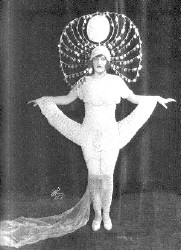
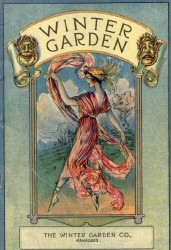 Passing
Show of 1924, The. Musical revue produced by Lee and J.J. Shubert that opened
on September 3, 1924, at Broadway's Winter Garden Theatre, where it ran until
November 24 for 106 performances. It was Joan's 2nd show for the Shuberts (the first, "Innocent
Eyes"), and she
(as "Lucille LeSueur") was paid $35 a week for her work in the chorus, where
she played, among other things, a "Beaded Bag" and "Miss Labor
Day." Credits: Music by Sigmund Romberg and Jean Schwartz. Book and Lyrics
by Harold Atteridge. Directed by J.C. Huffman. (JB, eBay info)
Passing
Show of 1924, The. Musical revue produced by Lee and J.J. Shubert that opened
on September 3, 1924, at Broadway's Winter Garden Theatre, where it ran until
November 24 for 106 performances. It was Joan's 2nd show for the Shuberts (the first, "Innocent
Eyes"), and she
(as "Lucille LeSueur") was paid $35 a week for her work in the chorus, where
she played, among other things, a "Beaded Bag" and "Miss Labor
Day." Credits: Music by Sigmund Romberg and Jean Schwartz. Book and Lyrics
by Harold Atteridge. Directed by J.C. Huffman. (JB, eBay info)
Internet Broadway Database info.
Password. Joan appeared on this CBS game show on December 16, 1962. See the 1960s TV page for more info and links to YouTube video clips from the show.
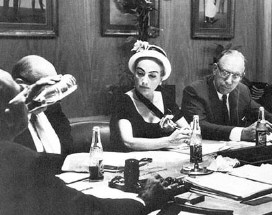 Pepsi-Cola.
Joan's 4th husband Alfred Steele was president of Pepsi. She travelled extensively
with him to promote the company then, after his death in 1959, was appointed
to its Board of Directors. At the urging of new president and Joan-nemesis
Don Kendall (nicknamed "Fang" by Joan), Pepsi forced her retirement in 1973. Click here
for a now infamous list of demands she made while travelling for them on business.
Pepsi-Cola.
Joan's 4th husband Alfred Steele was president of Pepsi. She travelled extensively
with him to promote the company then, after his death in 1959, was appointed
to its Board of Directors. At the urging of new president and Joan-nemesis
Don Kendall (nicknamed "Fang" by Joan), Pepsi forced her retirement in 1973. Click here
for a now infamous list of demands she made while travelling for them on business.
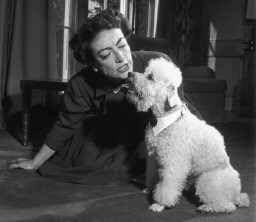 Pets
of Joan.
Pets
of Joan.
In 1932, Joan was pictured with a pet Scottie.
While married to Franchot Tone ('35 to '39), the couple had two dachshunds,
Pupschen and Baby. (Another source says "Pupschen and Stinky.") Pupschen
appeared with Joan in photos through the 1940s.
In the 1950s, Joan had poodles named Cliquot, Camille, and Chiffon.
(She was photographed with Cliquot as early as 1950; Chiffon was 3 years old in 1958, as evidenced by a 2004 eBay auction
for a dog permit that Joan applied for on 3/10/58.)
Two poodles appeared with her on the cover of 1971's
My Way of
Life. And
in a 1971
Christmas card,
she signed the names of poodles Chiffon, Ma Petite, and Masterpiece
the IV.
In her last years, Joan had a Shih
Tzu named "Princess Lotus
Blossom," which she gave away 2 days before her death.
Phone Numbers of Joan.
According to a letter to a fan, her Los Angeles business number in 1950 was CRestview 670-71.
According
to a letter to a colleague,
her personal NYC number in 1958 was YUkon 8-1155.
According
to a letter
to a Canadian Pepsi exec,
her personal NYC number in 1959 was MUrray Hill 8-4500,
ext. 308, during the day, and MUrray Hill 8-4508 at night
and on weekends.
According to a letter to George Cukor, her NYC number in 1965 was MUrray Hill 8-4500.
According to a 1964 letter to writer Robert Bloch and a 1967 letter to a friend, her personal LA number was GRanite 8-4279.
According to a letter to a fan, her Pepsi business number in NYC in 1967 was MU 8-4500.
In
a letter
of April 1974 to an industry friend
(while she lived in NYC's Imperial House 22H), she gives her number
as TR 9-7307.
According to the
Last Years bio, her last NYC phone number (also at Imperial House
22H) was 734-6969.
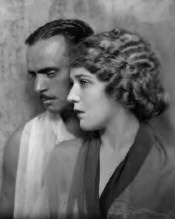 Pickford,
Mary. (4/8/1892 - 5/29/1979) For this site's purposes, Mary Pickford
was Joan's mother-in-law during her 1929-1932 marriage to Doug Fairbanks,
Jr. On a larger scale, though, Pickford was a groundbreaking actress and businesswoman,
by the late 1910s the highest-paid film star in America and most famous
woman in the world. She made around 236 films from 1909 until her film retirement
in 1933.
Pickford,
Mary. (4/8/1892 - 5/29/1979) For this site's purposes, Mary Pickford
was Joan's mother-in-law during her 1929-1932 marriage to Doug Fairbanks,
Jr. On a larger scale, though, Pickford was a groundbreaking actress and businesswoman,
by the late 1910s the highest-paid film star in America and most famous
woman in the world. She made around 236 films from 1909 until her film retirement
in 1933.
Some notable "firsts": Pickford was the first film star to get a closeup (in 1912's Friends); the first star to negotiate a percentage of a film's earnings; the first star (along with husband Doug Fairbanks, Sr., Chaplin, and D.W. Griffith) to create a production company (United Artists, 1920); the first (along with husband Fairbanks) to place her hand- and footprints at Grauman's Chinese Theater (4/30/27). In addition, she was also one of the 36 founders of the Academy of Motion Picture Arts and Sciences.
Pickford was born "Gladys Marie Smith" in Toronto to acting parents and toured with them beginning at age 6 as "Baby Gladys Smith." The family soon moved to the States and Pickford's New York stage debut (and debut of her new name) was in 1907 in David Belasco's "The Warrens of Virginia." She began her film career as an extra in 1909 with The Heart of an Outlaw after signing with D.W. Griffith's Biograph company, and soon graduated to leading roles and great fame. Through the 'teens, she was most acclaimed for her ringleted ingenue parts in silent films such as Tess of the Storm Country (1914), Poor Little Rich Girl (1917), Rebecca of Sunnybrook Farm (1917), Daddy Long Legs (1919), and Pollyanna (1920).
In 1920, after a disastrous 9-year first marriage to troubled (i.e. "drunken" and "drug-addicted" and "jealous") actor Owen Moore, she married a star very much on her level--Douglas Fairbanks, Sr. The two would only appear in one movie together (1929's The Taming of the Shrew), but were renowned worldwide for their very fame and "couple-dom" and entertainments at their Pickfair domicile (as well as their above-mentioned groundbreaking business collaborations).
In the '20s, Pickford attempted to establish a new, non-ingenue image for herself. She cut off her ringlets and tried to take on more adult roles--to some success, but her greatest fame was behind her. Her first talking picture, 1929's Coquette, gained her a Best Actress Oscar, but didn't translate into further popular adulation. She retired from films after 1933's Secrets and, after her 1936 divorce from Fairbanks, spent most of her subsequent time at Pickfair. (Pickford tried to make a comeback in 1948, lobbying hard for the lead role in 1948's I Remember Mama, which she lost to Irene Dunne.) In 1976, Pickford received an Oscar for Lifetime Achievement.
Here's an excerpt re Mary and Joan from Scott Eyman's 1990 Pickford bio:
In
1929, Douglas Fairbanks, Jr. had married Joan Crawford (nee Lucille
LeSueur), a working-class girl. Although born in San Antonio, she spent
a good part of her childhood in Lawton, Oklahoma. The mother of the
future novelist Gore Vidal had been warned about playing with Lucille
because her mother was “light,” or sexually promiscuous.
“Joan was a little bit on the
wild side,” remembered William Bakewell, who made several pictures with
her before she met Doug Jr. “She was always dancing the Charleston all
night long.” She was frozen with terror at her first meeting with her
step-mother-in-law, even wearing an extra pair of panties, just in case.
“I didn’t kiss her hand, did I?” she anxiously inquired of her husband
on their way home.
During ritualized Sunday visits,
Crawford, a sharp-eyed observer of the Fairbanks/Pickford marriage,
reported that, “Exuberant Douglas would come whirling into a room, pick
her up and hold her high in the air while she laughed her girlish laugh
and cried, ‘Now Douglas, put me down.’ She was enchanting with him and
he was obviously enchanted with her. She had the manner and bearing
of a little queen.”
Although Mary’s background
was no more exalted than Crawford’s, there was no discussion of the
difficulties of Making It. When Doug Sr. would take Doug Jr. off to
the studio for a sauna, Pickford would simply retire to her room, rather
ungraciously leaving Crawford alone to rattle around Pickfair as best
she could.
Occasionally, Mary would allow
Gwynne [her niece] to bring Crawford into her room while she decided on her wardrobe.
Crawford, deathly afraid of saying the wrong thing, felt it necessary
to call her “Ma’am.” It is a measure of the distance Pickford wanted
to keep, a measure of her insecurity at having a younger, more vibrant
personality under her roof, that it was not until Crawford and the younger
Fairbanks had been divorced for years that she allowed Joan to call
her “Mary.”
When the men returned, Pickford,
beautifully gowned, would descend. “During the time of that marriage,”
Crawford wrote about her step-mother-in-law, “we never had a word of
conversation save in a group of people.” (Her then-husband had a somewhat
different memory of those times together: “Mary,” he remembered, “is,
in my memories, always the essence of gentle, hospitable charm. Whenever
we were asked to the house she did all she could to make the clearly
shaky young girl feel at home – just as she had with me.”)
The reason for the steely forbearance
was probably two-fold: Pickford appears to have subtly disapproved of
young Doug’s choice of a bride – Crawford was unlettered and unsophisticated,
with none of the satined panache Mary had grown to deem important
– and there was the worry that this interloper might give her the entirely
unwanted gift of a grandchild.
Yet, Mary had a more-or-less
positive influence on her step-daughter-in-law. “Joan was always a strict
disciplinarian with herself as well as her children,” said William Bakewell.
“She was determined to be as much of a lady as Mary. It’s my feeling
that the impetus to cross over and be a lady that began around this
time was all wrapped up in Joan’s desire to have Mary approve of her.”
On one of the rare occasions
when the two couples were together, Doug Sr. suggested a trip to a dance
marathon on Santa Monica pier. “A couple have been dancing seventy-eight
hours,” he explained.
“Douglas, love, you know we
can’t be seen in such a place,” Mary replied. Douglas Fairbanks looked
at the woman that he loved and said, “Hipper, love, the steel hand is
showing through your velvet glove.”
(Thanks to Michael H. for contributing the book excerpt.)
IMDb Pickford page Official site Women in American History bio
Pitts, Zasu. (1/3/1894 - 6/7/1963) Star of over 200 films, and the star of Joan's very first billed film (1925) Pretty Ladies.
Plaza Art Galleries. Auction house on Manhattan's East Side (406 E. 79th St.) that sold nearly 1000 Joan items on February 16, 1978. The items were valued at $8,000, but brought in nearly $43,000. Among the items sold were 80 pairs of her false eyelashes for $300, and her personal autograph book, which brought $2,800. Click here to read the 2/17/78 New York Times article on the auction and see a sample authentication letter.
(Last Years; New York Times)
Poetry (by Joan). The first poem below appears in '62's Portrait of Joan autobiography. She says she wrote it in between marriages to Tone and Terry, during a time when she was also having an unsatisfactory affair with an unnamed married man. Says Joan in POJ: Turning your back on love spells loneliness. I cared for the babies and the days were busy, but when they were safely tucked in their cribs, I'd wonder why God had made me like this -- warm, loving, and so alone. I wasn't interested in the quick romance-- there's no satisfaction in that. I wanted to marry, give my children a father, go shopping for groceries, be part of the human race. I read poetry. I even wrote poetry:
Where are you?
My heart cries out in agony,
In my extended hands
I give my heart with
All its cries -- its songs -- its love,
But it's too late.
You are not here to see its sorrow
Or hear its throbbing of your name
Perhaps it's better that way
You who love laughter --
Did you ever know I love laughter too?
Oh my beloved
Where are you?
Here's another poem, which was handwritten and sent to Dan Mahony in a letter of 2/11/28:
I am condemned for everything I do,
Even for each and every little mood.
Everything's wrong and nothing is right,
However I guess that's all in life.--
But there's one little thought that give's [sic] me great peace--
In my own mind Im [sic] right at least.
And another handwritten poem to Mahony, in a letter of March 1928 (all spelling and grammar as in original):
"A Prayer"
Hail Mary Mother so full of grace
With your lovely Madonna face,
You've listened to hundred's of thousand's pray:
You in your Heaven so fair and so brave.
You've heard the secret prayers of a child
Ever so meek -- Ever so mild
The prayers of a mother you've heard & understood
Knowing in your heart all mother's are good
A murderer when all hope is gone
Turn's to you and thru darkness sees dawn
Even the strongest of all mankind
Beg your forgiveness, & worship your shrine
But Blessed Virgin Mary in your kingdom above
What equal's the beauty of a maiden in love?
I know for as a child I prayed to you
And as a mother I prayed for comfort too
But this prayer is neither of child or mother
It's the prayer of a girl who has a lover.
The one below was printed in the July 1928 issue of Motion Picture Classic:
"The Crack"
Funny thing this world!
How its lip does curl--
When it laughs at things you do,
After
it's taught those things to you.
No wonder we laugh and cry
And sometimes want to die.
Why, we're so awfully full of moods
We scarce know what to do.
Some say it's the individual--
Others that it's quite conventional.
But hot or cold--
The crack still goes--
Funny thing this world!
Poivre. See Fragrances.
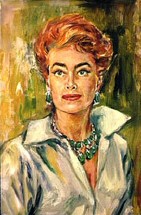 Portrait
of Joan, A. 1962
autobiography by Joan, co-written with Jane Kesner Ardmore
and published by Doubleday. See the Books
page for more info.
Portrait
of Joan, A. 1962
autobiography by Joan, co-written with Jane Kesner Ardmore
and published by Doubleday. See the Books
page for more info.
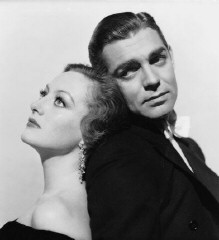 Possessed.
MGM, 1931. Directed by Clarence Brown, 76 minutes. Joan stars as factory worker "Marian,"
who yearns to dump her humdrum small-town life (and boyfriend) in favor of a
more glamorous big-city existence (and man). Clark
Gable (in their 3rd film together) plays a wealthy
politico who falls in love with her. Says Joan in CWJC: ...back
with Clark, both of us in strong parts, great reviews. Clarence Brown again,
thank God.
Possessed.
MGM, 1931. Directed by Clarence Brown, 76 minutes. Joan stars as factory worker "Marian,"
who yearns to dump her humdrum small-town life (and boyfriend) in favor of a
more glamorous big-city existence (and man). Clark
Gable (in their 3rd film together) plays a wealthy
politico who falls in love with her. Says Joan in CWJC: ...back
with Clark, both of us in strong parts, great reviews. Clarence Brown again,
thank God.
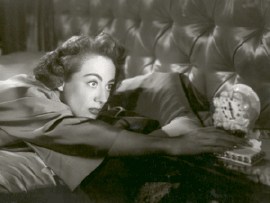 Possessed.
Warner Brothers, 1947. Directed by Curtis Bernhardt, 108 minutes. Joan stars
as the emotionally disturbed "Louise Howell," a nurse for a wealthy
man's wife. Louise loves a self-centered engineer (Van
Heflin)
who spurns her and then starts hanging around Louise's employer's daughter.
Louise gets very, very perturbed... Joan won her second Oscar
nomination for this role, but lost that year to Loretta Young in The Farmer's
Daughter.
Possessed.
Warner Brothers, 1947. Directed by Curtis Bernhardt, 108 minutes. Joan stars
as the emotionally disturbed "Louise Howell," a nurse for a wealthy
man's wife. Louise loves a self-centered engineer (Van
Heflin)
who spurns her and then starts hanging around Louise's employer's daughter.
Louise gets very, very perturbed... Joan won her second Oscar
nomination for this role, but lost that year to Loretta Young in The Farmer's
Daughter.
Says Joan in CWJC:
I think I worked harder on "Possessed" than on any other picture I ever made. Don't let anyone tell you it's easy to play a madwoman, particularly a psychotic. I used to think so, that you just pulled out all the stops and acted either manic or depressive and that was it. Both extremes have won, as you know, Oscars. But it's the wrong interpretation of psychosis, believe me, and I realized that just as we were ready to start production.
So I pulled a few strings here and there so I could actually observe what went on in psycho wards up in Santa Barbara and at hospitals in Santa Monica and at UCLA. I talked to psychiatrists; one was even kind enough to read the script and tell me how accurately it depicted a psychotic woman (for the most part it was on the nose) and how he thought I should handle the difficult scenes. I think it came off well. It was a heavy, heavy picture, not very pleasant, and I was emotionally and physically exhausted when we finished shooting. I don't think I'd have the strength to attempt anything like it again.
See also the Guy Maddin entry for the Canadian cultish director's take on the movie as an example of "life uninhibited" and on Joan's Medea-esque performance.
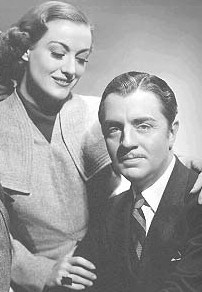 Powell,
William. (7/29/1892 - 3/5/1984) Born
in Pennsylvania, the suave Powell began his career on the New
York stage in 1912. He first appeared in British films, debuting
in 1922's Sherlock Holmes. He subsequently signed with Paramount
in 1924, then Warners in 1931, and finally MGM in 1934, where he
became a star with 1934's The Thin Man, which would garner
him his first Oscar nomination and spawn 4 sequels. (His other Oscar
nominations were for 1936's My Man Godfrey and 1947's Life
With Father, though he never won an Oscar.) His last film was
1955's Mister Roberts.
Powell,
William. (7/29/1892 - 3/5/1984) Born
in Pennsylvania, the suave Powell began his career on the New
York stage in 1912. He first appeared in British films, debuting
in 1922's Sherlock Holmes. He subsequently signed with Paramount
in 1924, then Warners in 1931, and finally MGM in 1934, where he
became a star with 1934's The Thin Man, which would garner
him his first Oscar nomination and spawn 4 sequels. (His other Oscar
nominations were for 1936's My Man Godfrey and 1947's Life
With Father, though he never won an Oscar.) His last film was
1955's Mister Roberts.
He and Joan appeared in only one film together, 1937's The Last of Mrs. Cheyney.
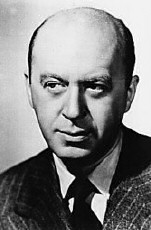 Preminger,
Otto. (12/5/06 - 4/23/86) The Austria-born Preminger worked as an
actor/director for Max Reinhardt's company in Vienna before making
his US directorial debut for 20th-Century Fox in 1936. His Oscar
nominations include 1945's Laura (Director), 1959's Anatomy
of a Murder (Picture), and 1963's The Cardinal (Director).
Other notable films: 1950's Where the Sidewalk Ends, 1955's
The Man With the Golden Arm, and 1962's Advise and Consent.
His last film was 1970's The Human Factor.
Preminger,
Otto. (12/5/06 - 4/23/86) The Austria-born Preminger worked as an
actor/director for Max Reinhardt's company in Vienna before making
his US directorial debut for 20th-Century Fox in 1936. His Oscar
nominations include 1945's Laura (Director), 1959's Anatomy
of a Murder (Picture), and 1963's The Cardinal (Director).
Other notable films: 1950's Where the Sidewalk Ends, 1955's
The Man With the Golden Arm, and 1962's Advise and Consent.
His last film was 1970's The Human Factor.
Preminger directed Joan in '47's Daisy Kenyon. Joan said of him in CWJC: "Otto is a dear man, sort of a Jewish Nazi, but I love him..."
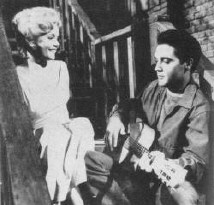 Presley,
Elvis. Joan
wrote Elvis a letter in March
1967,
thanking him for his, and Colonel Tom Parker's, kindness and mentioning
that Parker had given her an Elvis album (and the use of Elvis's
golf-cart while she was on the MGM set filming The Man from UNCLE).
Presley,
Elvis. Joan
wrote Elvis a letter in March
1967,
thanking him for his, and Colonel Tom Parker's, kindness and mentioning
that Parker had given her an Elvis album (and the use of Elvis's
golf-cart while she was on the MGM set filming The Man from UNCLE).
In the book Elvis Aaron Presley: Revelations from the Memphis Mafia, Elvis's cousin Billy Smith tells of an unpleasant encounter between Christina Crawford and Elvis in 1961:
Christina Crawford, who had a bit part in "Wild in the Country," came up to the house one night to see Joe Esposito. She's Joan Crawford's adopted daughter, the one who wrote Mommie Dearest. Elvis was smoking cigars that night, and every time he'd take one out, Joe would start to light it for him, and Christina would reach out and grab it and break it.And Elvis said, "Don't do that, that's not funny." So he picked up another one, and Joe went to light it again. And she broke it again. And Elvis said, "I've asked you nicely." She said, "Well, he shouldn't have to light your cigars" and Elvis said, "Look he works for me goddammit, and knows when I get a cigar to light it for me."
But she did it a third time, and boy Elvis got mad. They got into a barrage of words. Elvis said, "Look you bitch--" and Christina threw a drink in his face. He stopped a minute and then he said "I'm going to eliminate this problem." He got up and stepped on the top of this five by six marble coffee table we had and grabbed her by her ponytail and dragged her across the damn table out of the room. Then he kicked her right in the rear as she was going out the door. It wasn't but a short time later that she came back up and apologized. She said the reason she'd done it was because she resented seeing her mother treat everybody who worked for her the same way.
Thanks to Jeff Davidson for contributing this anecdote.
 Pretty
Ladies. MGM silent, 1925. Directed by Monta Bell, 74 minutes. In her first
credited role, Joan has a
small part as "Bobby," a showgirl in the Ziegfeld
Follies, and is billed by her real name
of "Lucille LeSueur" for the first and only time. Says Joan in CWJC: ...I don't think I was
noticed by anyone.
Pretty
Ladies. MGM silent, 1925. Directed by Monta Bell, 74 minutes. In her first
credited role, Joan has a
small part as "Bobby," a showgirl in the Ziegfeld
Follies, and is billed by her real name
of "Lucille LeSueur" for the first and only time. Says Joan in CWJC: ...I don't think I was
noticed by anyone.
Proud Flesh. MGM silent, 1925. Directed by King Vidor. In this, Joan's second film appearance (after Lady of the Night), she appears as an uncredited extra.
Proud Flesh page.
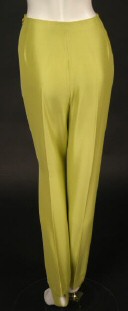 Pucci
pants. Joan favored wearing these while on vacation in Capri, Jamaica, and
Barbados. (But otherwise, she considered pants strictly for the home. See the
Louis B. Mayer entry for insight into what probably unleashed her horror!) (MWOL)
Pucci
pants. Joan favored wearing these while on vacation in Capri, Jamaica, and
Barbados. (But otherwise, she considered pants strictly for the home. See the
Louis B. Mayer entry for insight into what probably unleashed her horror!) (MWOL)
Pictured: A pair of chartreuse silk Pucci pants from the '60s...such as Joan might have worn!